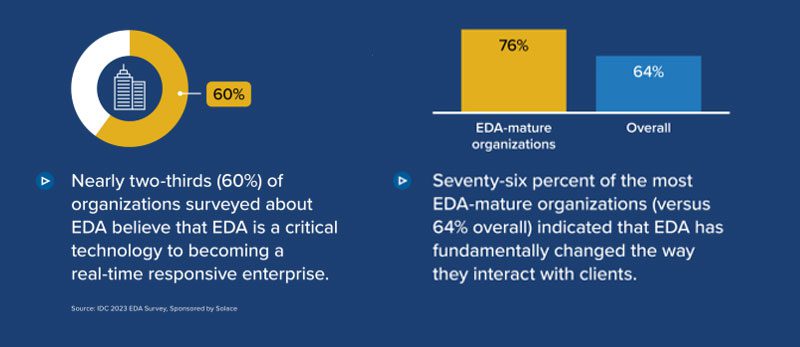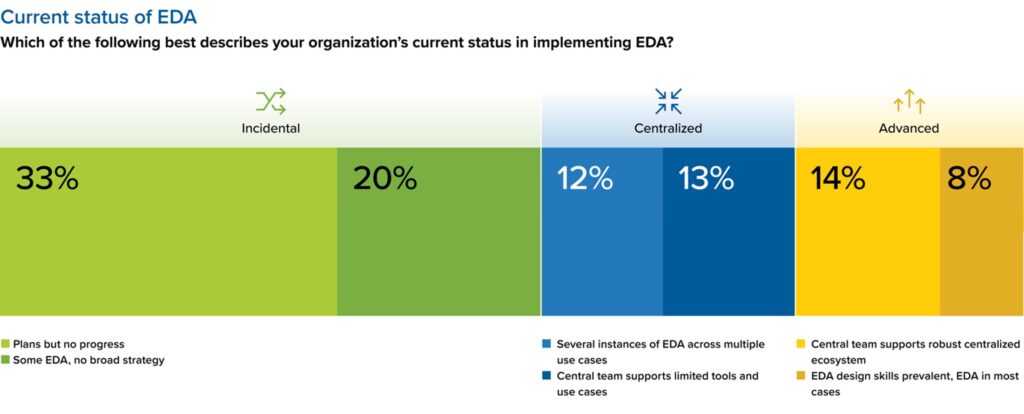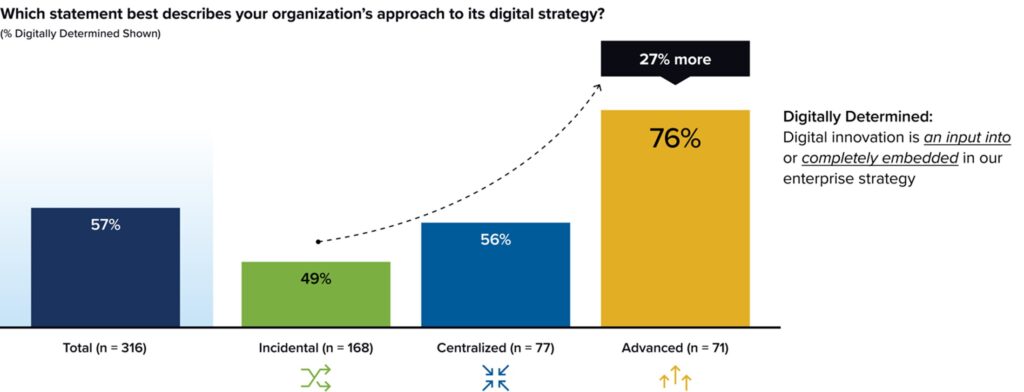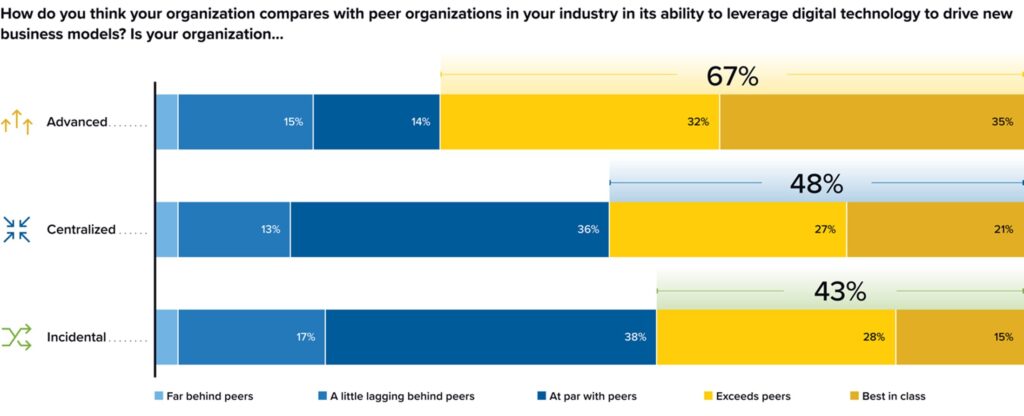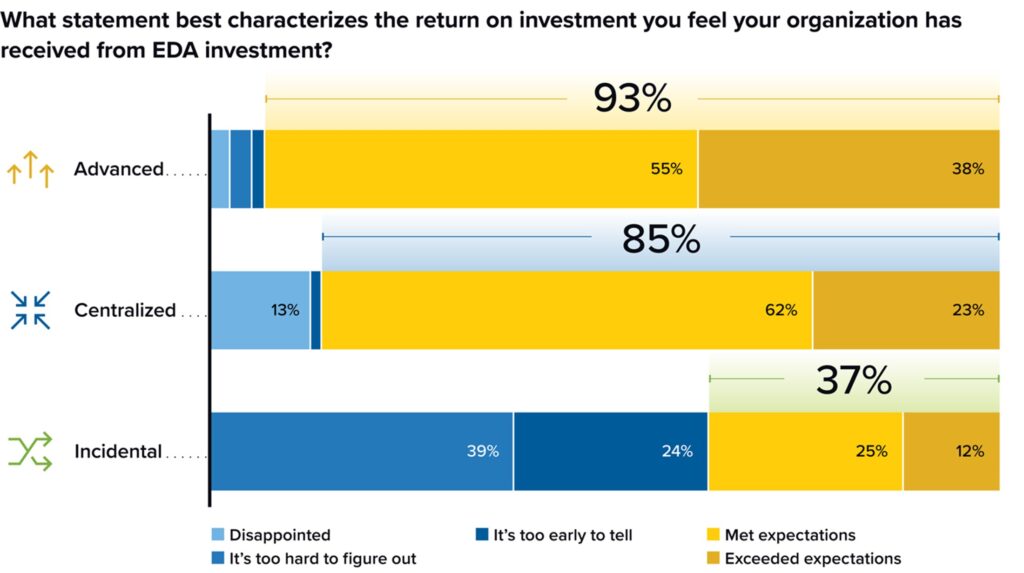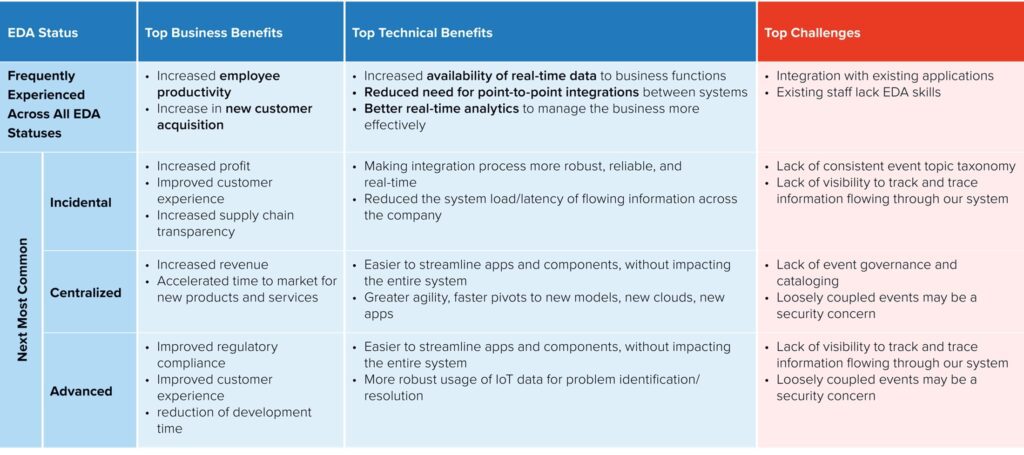Home > Blog > IDC Survey: The Exponential Business Value of Real-Time Event-Driven Data Flows
IDC has published an InfoBrief sponsored by Solace that summarized the findings of an extensive survey on the adoption and business value of event-driven architecture (EDA). With this post I’ll summarize the findings.
EDA Adoption Trends
You can see that EDA is viewed by those using it as critical to their enterprise and digital business initiatives.
When survey respondents were provided with maturity framework, almost have (47%) considered themselves “Centralized” or “Advanced” in terms of maturity.
But what became clear was that EDA adoption is linked to an organization’s overall digital maturity, as those with higher levels of EDA maturity also had higher levels of digital maturity.
EDA Drives Competitive Advantage
IDC found that those organizations with higher levels of EDA maturity were also more likely to consider themselves ahead of their peers in developing digital business models.
Most Prevalent Use Cases
Ok, so organizations are in fact using and benefiting from EDA and event-driven applications, what are they using it for? The IDC study found the top 3 use cases are IoT, developing distributed applications, and sharing data across applications. IDC also found that use cases often become interdependent over time. For example, published IoT data may initially be consumed to trigger alerts, but over time it may also be consumed by business and analytics systems to support decisions, trigger automated actions or initiate new messages that are consumed by other systems. They also found that most organizations are planning to add 2-3 more use cases in the next 24 months.
Business and Technology Benefits
IDC found that when organizations implement EDA, the benefits can seem very technical at first, and while this is certainly true, there are also strong business benefits that emerge. They also found that when organizations have up-to-date, synchronized data available everywhere, applications and employees can more quickly and easily identify and respond to threats, opportunities and to shifting market and customer demands.
The ROI of EDA is Clear
The IDC study found that having a structured approach to EDA leads to a strong return on investment (ROI). Organizations have to realize that EDA is not a single project, but a strategy, and its benefits compound with time and additional use cases. As shown below, 93% of organizations with Advanced EDA maturity found that EDA met or exceeded their expectations, so it was found to be very important to stay focused on the journey and rewards will follow.
Key Challenges and the Pathway to Success
No technology comes without challenges, and EDA is no exception. Security and governance seemed to be the most widely cited challenge, followed by a lack of EDA skills. Below you can see how the technical and business benefits fared alongside the challenges when looking at it through the lens of EDA maturity.
5 Keys to EDA ROI and Success
Through the extensive survey to users of Event-Driven Architecture, IDC was able to determine 5 keys to success with EDA initiatives:
- Engage the C-Suite as primary supporters: It was found that successful organizations had strong C-suite support (LOB and/or IT) in the early stages, when ROI and business benefits are not immediately clear. As your maturity increases, and the business impact becomes more apparent, the need for executive support becomes less critical.
- IT needs to address technical complexity head on: As EDA use becomes more prevalent, challenges like in-house EDA skills and event governance become more apparent. IDC suggests building EDA skills internally and finding the right technology partner as critical to success.
- Communicate the benefits of EDA and create alignment between IT and the business: It became apparent through the survey that in the early stages of EDA maturity, a lack of awareness of benefits was the most frequently cited of the organizational challenges. As maturity increases, cost concerns and finding the right use cases could hamper further success. IDC suggested a focus on change management and communicating business benefits as essential to overcoming these challenges.
- Implement the right measures of success, and evolve these as your EDA use cases proliferate: It was found that organizations just starting with EDA were typically concerned with cost reduction and number of completed projects, which are difficult metrics to prove business impact. But organizations who were more mature and successful with tended to focus on revenue, operational stability and resiliency as their key metrics.
- Accelerate EDA implementation with external business partners and effective change management: The survey found that finding a supportive partner to assist with the implementation of EDA and to explain leading methodologies were among top organizational considerations, and momentum can be sustained by using a robust change management plan.
Source: IDC InfoBrief “Getting in Sync: Unlocking the Exponential Business Value of Real-Time Event-Driven Data Flows”, Shari Lava, April 2023

As the leader of Solace’s analyst relations program, Roger has leveraged his technical background and analyst relations experience to develop a solid technical understanding of event-driven architecture, event streaming and event management that he uses to help analysts understand the many ways EDA and events can enable, complement, and accelerate the latest trends in computing and technology.
After kicking off his career as a programmer and professional services consultant, Roger shifted his focus to analyst relations with business intelligence innovator Cognos and IBM’s Business Analytics and Global Business Services consulting division when IBM acquired them, and for 20 years now he’s been working alongside Gartner, Forrester, IDC and other analysts to help them understand his employers’ position in the enterprise IT landscape.
Married for 30 years, Roger is the proud father of 3 adult children and enjoys DIY projects around the house and spending quiet time at the lake.


Subscribe to Our Blog
Get the latest trends, solutions, and insights into the event-driven future every week.
By submitting this form, you agree to Solace’s privacy policy: solace.com/privacy-policy/
Thanks for subscribing.

